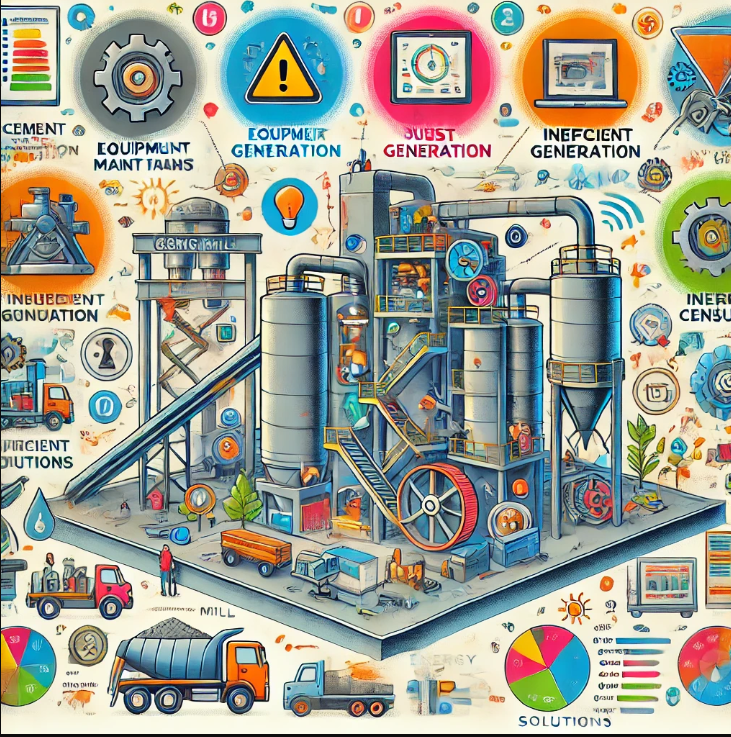Contents
Common problems in cement mill operations frequent issues encountered in cement mills and how to address them

TO Download this post and all the books and excel sheets and my personal notes and presentations I collected about cement industry in the last 30 years click the below paypal link
Common Problems in Cement Mill Operations and How to Address Them
Cement mill operations are complex and involve numerous mechanical and operational challenges. Addressing these issues is crucial to maintaining productivity and ensuring efficient operations. Below are some of the most common problems encountered in cement mills, along with strategies to mitigate them.
1. Ball Charge Management
- Problem: Over time, the grinding media (balls) in the mill can wear down, reducing the mill’s grinding efficiency and output. Improperly balanced ball charges can lead to excessive wear, high energy consumption, and reduced throughput.
- Solution: Regularly monitor and adjust the ball charge to maintain an optimal level. Implement a ball wear monitoring system and replace worn-out balls to ensure efficient grinding.
2. Inconsistent Product Quality
- Problem: Variability in the fineness of the cement product can lead to inconsistent quality, affecting the strength and durability of the cement. This is often due to fluctuations in the feed material, changes in the mill’s operating conditions, or improper separator settings.
- Solution: Implement a robust quality control system that includes real-time monitoring of product fineness. Adjust the separator and mill settings as necessary to maintain consistent output. Consider automating the control process with advanced process control systems.
3. Overheating of Mill Bearings
- Problem: The bearings in cement mills can overheat due to excessive load, improper lubrication, or contamination, leading to bearing failure and unplanned downtime.
- Solution: Ensure proper lubrication of the bearings and regularly inspect them for signs of wear or contamination. Consider installing temperature sensors to monitor bearing conditions and prevent overheating.
4. Mill Vibration
- Problem: Excessive vibration in the mill can result from imbalanced grinding media, misaligned gears, or worn-out components. This can lead to structural damage, reduced efficiency, and increased maintenance costs.
- Solution: Regularly check the alignment of gears, balance the grinding media, and inspect for any worn-out components. Address any sources of vibration promptly to prevent further damage.
5. High Energy Consumption
- Problem: Cement mills are energy-intensive, and high energy consumption can significantly impact operational costs. Factors contributing to high energy usage include inefficient grinding media, suboptimal mill ventilation, and outdated control systems.
- Solution: Optimize the grinding process by ensuring the correct ball charge, improving mill ventilation, and upgrading to energy-efficient motors and control systems. Regularly review and adjust the operational parameters to reduce energy consumption.
6. Blockages and Material Build-Up
- Problem: Material blockages in the mill can lead to reduced throughput and operational disruptions. This issue is often caused by improper material feed, moisture content, or inadequate ventilation.
- Solution: Regularly inspect the material feed system and ensure it is functioning correctly. Manage the moisture content of the raw materials and improve mill ventilation to prevent blockages. Implement a cleaning and maintenance schedule to remove any build-up.
7. Wear and Tear on Internal Components
- Problem: The internal components of a cement mill, such as liners and grinding media, are subject to wear and tear over time, which can lead to reduced efficiency and increased maintenance costs.
- Solution: Monitor the condition of internal components regularly and replace them when necessary. Use wear-resistant materials for liners and grinding media to extend their lifespan. Implement a predictive maintenance program to address wear before it leads to equipment failure.
8. Inadequate Mill Ventilation
- Problem: Poor ventilation in the mill can lead to overheating, inefficient grinding, and product quality issues. It can also contribute to the build-up of dust and other particulates.
- Solution: Optimize the ventilation system by adjusting fan speeds and maintaining clean filters. Consider installing variable speed drives (VSDs) to control airflow more effectively. Regularly inspect and clean the ventilation system to ensure it operates efficiently.
9. Dust Emissions
- Problem: Excessive dust emissions from the mill can create health hazards for workers and environmental compliance issues. This problem is often caused by poor sealing, inadequate dust collection systems, or excessive material handling.
- Solution: Improve the sealing of the mill and upgrade the dust collection system to capture more particulates. Implement dust suppression measures and ensure that all material handling processes are enclosed to minimize dust generation.
10. Operational Downtime
- Problem: Unplanned downtime due to mechanical failures, maintenance, or operational issues can lead to significant production losses and increased costs.
- Solution: Implement a comprehensive preventive maintenance program that includes regular inspections, timely repairs, and predictive maintenance technologies. Invest in reliable equipment and train operators to recognize early signs of potential failures.
Conclusion
Addressing these common problems in cement mill operations is essential for maintaining high levels of productivity, efficiency, and product quality. By implementing the solutions discussed, cement plant operators can minimize downtime, reduce costs, and improve the overall performance of their mills.
Sources and References
- International Cement Review – “Ball Charge Management in Cement Mills.” Available at: https://www.cemnet.com/Articles/story/170970/ball-charge-management.html
- World Cement – “Quality Control in Cement Production.” Available at: https://www.worldcement.com/quality-control/
- Cement Equipment – “Bearing Maintenance in Cement Mills.” Available at: https://www.cementequipment.org/articles/bearing-maintenance/
- FLSmidth – “Vibration Analysis in Cement Mills.” Available at: https://www.flsmidth.com/en-us/articles/vibration-analysis
- IEEE Xplore – “Energy Management in Cement Industry.” Available at: https://ieeexplore.ieee.org/document/9010481
- Reliabilityweb – “Preventing Blockages in Cement Mills.” Available at: https://www.reliabilityweb.com/articles/entry/preventing-blockages-in-cement-mills
- Scribd – “Wear and Tear in Cement Mills.” Available at: https://www.scribd.com/document/33345678/Cement-Mill-Notebook
- Rockwell Automation – “Optimizing Mill Ventilation.” Available at: https://www.rockwellautomation.com/en-us/articles/optimizing-mill-ventilation.html
- World Cement – “Dust Emission Control in Cement Plants.” Available at: https://www.worldcement.com/dust-emission-control/
- Maintenance Technology – “Reducing Operational Downtime in Cement Mills.” Available at: https://www.maintenancetechnology.com/reducing-operational-downtime-in-cement-mills/
TO Download this post and all the books and excel sheets and my personal notes and presentations I collected about cement industry in the last 30 years click the below paypal link
